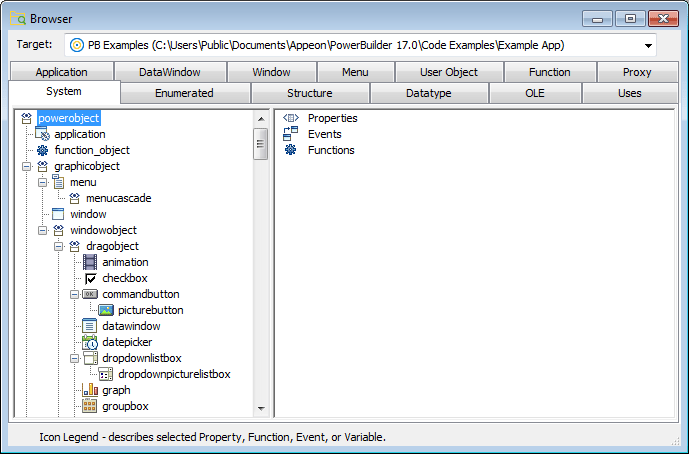PowerBuilder provides a Browser that can show the hierarchy of the built-in PowerBuilder system objects and the hierarchy of ancestor and descendant windows, menus, and user objects you create. In object-oriented terms, these are called class hierarchies: each PowerBuilder object defines a class.
Regenerating objects
The Browser also provides a convenient way to regenerate objects and their descendants. For more information, see Regenerating library entries.
To browse the class hierarchy of PowerBuilder system objects:
-
Click the Browser button in the PowerBar.
-
Choose the System tab to show the built-in PowerBuilder objects.
-
In the left pane, scroll down the object list and select the powerobject.
-
Display the pop-up menu for the powerobject and choose Show Hierarchy.
-
Select Expand All from the pop-up menu and scroll to the top.
The hierarchy for the built-in PowerBuilder objects displays.
Getting context-sensitive Help in the Browser
To get context-sensitive Help for an object, control, or function, select Help from its pop-up menu.
To display the class hierarchy for other object types:
-
Choose the Menu, Window, or User Object tab.
If you choose any other object type, there is no inheritance for the object type, so you cannot display a class hierarchy.
-
In the left pane, select an object and choose Show Hierarchy from its pop-up menu.
-
Select an object and choose Expand All from its pop-up menu.
PowerBuilder shows the selected object in the current application. Descendant objects are shown indented under their ancestors.
For example, if your application uses the PBDOM PowerBuilder extension object, the pbdom_object displays on the User Object page. You can select Show Hierarchy and Expand All from its pop-up menu to display its descendant objects.



